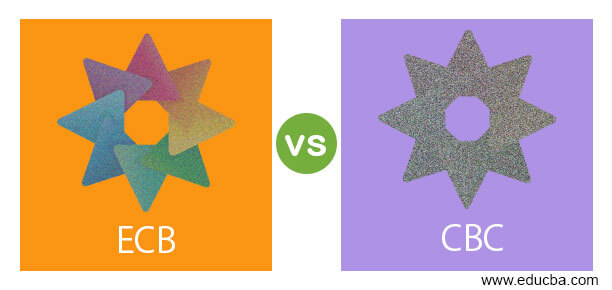Updated May 6, 2023

Difference between ECB vs CBC
ECB and CBC are algorithm modes, both work on a block cipher. Block cipher is a technique that encrypts one block of text at a time and decrypts one block of encrypted text at a time. Algorithm mode is a combination of a series of the basic algorithm steps on block ciphers and some kind of feedback from previous steps. Electronic Code Book (ECB) and Cipher Block Chaining (CBC) are two encryption techniques. ECB is suitable for encrypting small messages, while CBC is better suited for encrypting large messages. In this topic, we are going to learn about ECB vs CBC.
What is ECB?
ECB (Electronic Codebook) is the simplest mode of operation. In this algorithm mode, at the sender site, plain text messages are divided into sub-blocks each of 64 bits. Each sub-block is encrypted independently in this process. To encrypt all blocks the same key is used and generates the ciphertext. At the receiver’s end, the incoming ciphertext is divided into sub-blocks, each consisting of 64 bits. The receiver uses the same key that was used for encryption to decrypt each ciphertext block and generate the corresponding plain text block. Since ECB uses the same key to encrypt all blocks, if a plain text block is repeated in the original message, the corresponding ciphertext will also repeat. Therefore, ECB is typically used for encrypting small messages.
What is CBC?
Cipher Block Chaining (CBC) mode, which operates on block ciphers, ensures that even if a block of plain text is repeated, a different ciphertext is generated for each corresponding block of plain text. To implement this, CBC uses a feedback mechanism. The encryption process for plain text messages in this system involves dividing them into sub-blocks of 64 bits. To encrypt a message in this system, the first block of plain text and IV are combined using XOR and encrypted using a key to produce the first block of ciphertext. Next, each subsequent block of plain text is combined with the previous block of ciphertext using XOR, and the resulting block is encrypted using the key. This process continues for all blocks of the message. The same key is used for all blocks.
At the receiver side, the decryption process starts by decrypting the first block of ciphertext using the same key used for encryption. Then, the resulting plaintext and IV are combined using XOR to generate the corresponding plaintext block. The same process is repeated for each subsequent block of ciphertext, where the block is decrypted using the same key and then combined with the previous plaintext block using XOR to generate the next plaintext block. The same is continued for all blocks.
Head to Head Comparison between ECB vs CBC (Infographics)
Below are the top differences between ECB vs CBC.
Key Differences Between ECB and CBC
- ECB stands for Electronic Code Book while CBC stands for Cipher Block Chaining.
- ECB is used for transmitting a single value whereas CBC mode is used for a block of text authentication,
- In ECB, each block of ciphertext that is encrypted is independent of other cipher blocks, whereas in CBC each block of ciphertext is dependent on the corresponding current input plain text as well as a previous plain text block,
- ECB neither uses IV factor nor performed the XOR operations, whereas CBC uses both IV factor and XOR Operation.
Electronic code block does use a feedback mechanism whereas Cipher Block Chaining uses a feedback mechanism. - If a plain text block is repeated in the original message, Electronic Code Book (ECB) mode generates the same ciphertext block for each corresponding plain text block, whereas Cipher Block Chaining (CBC) mode generates different ciphertext blocks for each corresponding plain text block.
- ECB mode is used for encrypting small messages as the chances of decoding the ciphertext are higher. In contrast, CBC mode is used for encrypting large messages as the chances of decoding the ciphertext are much lower.
Comparison Table for ECB and CBC
Below is the comparison table which lists out the difference between the ECB and CBC.
| Sr. No | ECB | CBC |
| 1 | ECB stands for Electronic Code Book | CBC stands for Cipher Block Chaining |
| 2 | It is used for the transmission of a single value in a secure manner | It is used for encrypting blocks of text authentication. |
| 3 | It is suitable for encrypting small messages | It is suitable for encrypting the large messages. |
| 4 | In ECB mode, it is easy to decode the ciphertext. | In CBC, it is quite difficult for the attacker to decode the ciphertext. |
| 5 | If a block of plain text is repeated in the original message, the corresponding ciphertext block will also repeat in the encrypted message. | if the block of plain text is repeated in the original message, CBC will generate different ciphertext blocks for the repeated block of plain text. |
| 6 | ECB does not make use of the feedback mechanism | CBC makes use of a feedback mechanism. |
| 7 | In CBC, each block of ciphertext is independent of other blocks | In CBC mode, each block of ciphertext is dependent on the corresponding current input plain text block as well as the previous plain text block. |
| 8 | ECB does not use IV (Initialization Vector) | CBC uses IV (Initialization Vector). |
| 9 | ECB does not perform XOR operation | CBC performs the XOR operation. |
Conclusion
In this article, we have seen what is EBC and CBC along with key differences between them. We hope you will find this article helpful.
Recommended Articles
We hope that this EDUCBA information on “ECB vs CBC” was beneficial to you. You can view EDUCBA’s recommended articles for more information.

